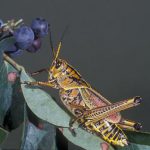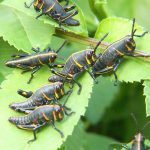Do you know the song, “The ants go marching one by one; hurrah, hurrah”? Picture in place of the ants, grasshoppers. Not just any grasshopper, but the Eastern lubber grasshopper, Romalea microptera. If you have ever had the opportunity to cross paths with this grasshopper, you might agree that witnessing them march, one by one, is quite a sight to behold!
The first time I came across this six-legged creature was in Louisiana, where locals refer to them as “devil’s ponies” or “devil’s horses.” The lubbers had completely defoliated my neighbor’s variegated ginger plants. Yes, their insatiable appetite is as impressive as their size!
Lubber: General Characteristics
The Eastern lubber grasshopper is native to Florida and one of the largest grasshoppers in North America. This grasshopper are found throughout the southeastern part of the United States, from North Carolina down to Florida and west to Texas. It is large compared to most insects, ranging from 1.5 to 4 inches long. The females are generally larger than the males.
Adult colors vary, but most common are a vibrant yellow with black and orange accents. This bright coloration is called aposematism, the insect’s way of advertising to potential predators that it is best to leave it alone or suffer the consequences. In this case, the lubber sequesters and synthesizes toxins from the plants it eats, like the monarch caterpillar. It can secrete an awful smelling toxic froth from spiracles along the side of its body when threatened, and can even spray this toxin up to six inches to escape potential predators.
The adult lubber has wings, but it does not fly. It has large, stout legs, but it’s not very good at jumping either. Are you wondering exactly how does this grasshopper get around? The lubber walks from place to place—plant to plant. The name “lubber” comes from an old English word, “lobre,” that means lazy or clumsy. This is a perfect description of its meander, as it looks for the next meal.
What lubbers lack in the jumping category, they make up in climbing. A lubber can easily scale trees in order to feed on the tender, new foliage.
Favorite Foods
Eastern lubbers are not picky eaters. They have been documented feeding on more than 100 plant species from 38 different families. They feed on ornamental plants, as well as a variety of row crops and citrus groves. Their mouthparts are most suited for feeding on broadleaf plants, and they graze on many different plants, though usually create minimal damage. There is one plant family that lubbers favor, however: Amaryllidaceae, which includes amaryllis, lily, crinum, and narcissus. Once lubbers start to feed on one of these plants, they will completely defoliate the plant, down to the stock.
The Lubber Life Cycle

Adults start to appear in April, and populations peak in our late summer/autumn, between October and November. In the summer, adult females lay their eggs in holes dug in low, moist areas. This is usually on the edge of natural areas such as pine habitats, so the emerging nymphs can disperse easily. Females dig a shallow hole and lay a “pod” of eggs, typically around 60 eggs. The females cover the hole with a frothy plug sealing in the eggs, but the plug remains pliable enough to allow the emerging nymphs to exit.
There is one generation per year, but the adult females average one to five egg clusters per season. The time between egg pod production is about two weeks. The eggs overwinter in the egg stage for six to eight months, and the young nymphs emerge in early February.

The immature stages of the Eastern lubber are quite different looking from the adult. They are typically solid black with a bright red, orange, or yellow strip that runs along the back from the head to end of the abdomen. They change colors as they progress through their molts, and people often mistake the nymphs for another species of grasshopper altogether. The immature stage consumes plant material at an alarming rate.

Lubber nymphs are gregarious and can defoliate ornamental plantings with impressive speed. The damage to the plant is only cosmetic, however, and the plant will recover. The nymphs progress through five or six instars (molts), before emerging as fully formed adult lubbers around April or early May.
Management
Easter lubbers are rarely a problem in the home landscape. Monitoring areas where the lubber is known to occur is the best management practice for controlling the insect. Other ways to reduce grasshopper numbers include controlling weeds, keeping border areas between manicured and natural areas mowed, and planting ornamentals that are less attractive to the lubbers.
Scouting is important once hatching season begins. When the immature lubbers emerge, they can be picked off the plants by hand and tossed in a bucket of soapy water. Controlling the immature stages is key. If hand-picking is unsuccessful, applications of the microbial product Spinosad can be used on the immatures. This product acts slowly but effectively. And, since it is a microbial agent, it is safe around pets and children.
Insecticidal sprays are not effective against adult lubbers, given their size and ability to detoxify natural toxins. There are commercial insecticide baits formulated for controlling lubbers, which can be used against all stages of the insect. If all other management strategies have failed and an insecticidal product is necessary, be sure to read the product label and apply according to the label directions.
Resources
If you are interested in learning more about the Eastern Lubber grasshopper:
- The Eastern Lubber Grasshopper: Hard to Miss, But Only an Occasional Pest (Entomology Today)
- Eastern Lubber Grasshopper, Romalea microptera (UF/IFAS Extension EDIS)
- The Eastern Lubber Grasshopper (Florida Department of Agriculture and Consumer Services)
 0
0
